I am trying to have a small signal analysis of a Wilson BJT current mirror to find out what is the output impedance. Already I know that the answer is $$R_o=\beta r_o/2$$
In the first step, I need to draw the small signal model. My model is different from what is depicted here:
 More confusing about this model is the direction of \$I_{C3}\$.
I find another model in my textbook which is somehow the one that I expected, but still not quite the same:
More confusing about this model is the direction of \$I_{C3}\$.
I find another model in my textbook which is somehow the one that I expected, but still not quite the same:

 I expect to see \$r_{\pi 1}\$ in the model and I cannot understand where \$1/g_{m2}\$ comes from.
I expect to see \$r_{\pi 1}\$ in the model and I cannot understand where \$1/g_{m2}\$ comes from.
-
1Q2 is a diode-connected BJT, The Rout for diode-connected BJT is equal to: \$r_{out} = \frac{1}{gm}||r_\pi||r_o \approx \frac{1}{gm} \$ Also notice that 1/gm2 is much smaller then r_pi1, and this is why they omitted r_pi1 from the diagram. – G36 Aug 19 '22 at 18:52
-
@G36 thank you. I got it. Is there another assumption that I can take and make KCL and KVL easier? I am not able to reach to the answer. Ro=Bro/2 – chami Aug 19 '22 at 20:40
-
Which small-signal mode did you decide to use? – G36 Aug 20 '22 at 06:37
-
@G36 second one! It seems easier to follow! – chami Aug 21 '22 at 07:23
1 Answers
The simplified small-signal model Wilson current mirror will look like this:

simulate this circuit – Schematic created using CircuitLab
Now we can write KCL:
$$V_X = (I_X - I_{C3})r_{o3} + V_{BE}$$
Also notice that \$V_{BE1} = V_{BE2} = V_{BE}\$ and that: \$I_X = g_{m2}V_{BE} + g_{m1}V_{BE}\$
And from this we have -> \$V_{BE} = \frac{I_X}{ g_{m1}+ g_{m2}}\$
Next \$I_{C3}\$ current
$$I_{C3} = V_{BE3}*g_{m3} =- V_{BE}*g_{m2}*r_{\pi3}*g_{m3} = $$ $$ = -\frac{I_X}{ g_{m1}+ g_{m2}}*g_{m2}*r_{\pi3}*g_{m3} = -\frac{g_{m2}\: g_{m3}\: r_{\pi3}}{g_{m1}+ g_{m2}}I_X $$
Therefore:
$$V_X = \left(I_X - (-\frac{g_{m2}\: g_{m3}\: r_{\pi3}}{g_{m1}+ g_{m2}}I_X )\right)r_{o3} + \frac{I_X}{ g_{m1}+ g_{m2}} = $$
$$ = \left(I_X + \frac{g_{m2}\: g_{m3}\: r_{\pi3}}{g_{m1}+ g_{m2}}\:I_X \right)r_{o3} + \frac{I_X}{ g_{m1}+ g_{m2}}$$
$$V_X = I_X \left(\frac{g_{m2}\: g_{m3}\: r_{\pi3} }{g_{m1}+ g_{m2}} r_{o3} + r_{o3} + \frac{1}{g_{m1}+ g_{m2}} \right)$$
$$V_X = I_X \left( \left(\frac{g_{m2}\: g_{m3}\:r_{\pi3} }{g_{m1}+ g_{m2}} +1\right)r_{o3}+\frac{1}{g_{m1}+ g_{m2}} \right)$$
And finally, we have the output impedance value:
$$R_{OUT} = \frac{V_X}{I_X} = \left(\frac{g_{m2}\: g_{m3}\:r_{\pi3} }{g_{m1}+ g_{m2}} +1\right)r_{o3}+\frac{1}{g_{m1}+ g_{m2}} $$
Additional notice that: \$\:\large g_{m3}\:r_{\pi3} = \beta_3 \$
and \$ \large g_{m1} = g_{m2}\$ thus
\$ \large \frac{g_{m2}}{g_{m1}+ g_{m2}} = \frac{1}{2}\$
So we can simplify the equation
$$R_{OUT} = \left(\frac{g_{m2}\: \beta_3}{g_{m1}+ g_{m2}} + 1\right)r_{o3}+\frac{1}{g_{m1}+ g_{m2}} $$
$$\large R_{OUT} \approx \left(\frac{\beta_3}{2}+ 1\right)r_{o3}$$
I hope this will help you.
- 13,642
- 1
- 18
- 33